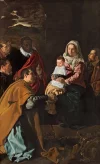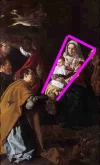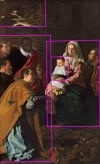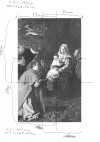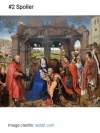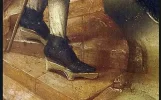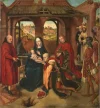To all of you:
You are still far from the point, and I can tell you that it is information that is worth gold, it is really valuable to understand a painting. It is something that applies even today, and it is a very old discovery.
I look at your posts very frequently, and if I don't answer anything, it's because I don't want to fill the post with my comment boxes, it would be unsightly and even an intrusion into a beautiful world of comments and interesting ideas and full of friendship between the participants.
In the meantime, I will say some curious things about the painting.
The model for the Virgin Mary is Juana Pacheco, Velazquez's wife.
Velazquez was 19 or 20 years old when he painted the picture, (!!!!!!!) he was born on June 6, 1599. It is a beautiful day to be born, on the 6th of 6. I was also born that same day, but a few years later.
The wizard king at the bottom left, is Velazquez himself, it is his self-portrait.
Juana Pacheco was the daughter of his teacher, they married in 1617, when she was 15 years old. Therefore, in the painting, Maria is about 17 years old. It is true that her hands in the painting do not correspond to her face. And less with a 16 or 17 year old girl. Knowing that Velazquez corrected his pictures, and this is visible in the x-rays that are made during restorations, and I have them, if he painted and left his hands like that, it is because he wanted to do it. Perhaps to give a feeling of strength, stability, security.
Velazquez began studying painting with professional teachers when he was 10 (!!) years old. With Pacheco he was from 11 to 17, he finished his studies and received his license to paint.
In Velazquez's time, and I suppose that today among the majority of Catholics in Spain, it is assumed that the night Jesus was born was when he received the adoration of the Magi, Melchior, Gaspar and Baltasar and of the shepherds. Therefore, a single act is represented in a single moment, without further complications. And as I write this, it occurs to me that humanity is symbolized or represented by it: shepherds represent a poor part of society, kings represent another rich and cultured part, and shepherds, at the same time, represent those who later They will take care of the flock of God, us, with their priests or shepherds. This is nothing more than my elucubration of this moment.
Well, I do not want to lengthen the topic and the emotion more than necessary for you, for me it is very good if it lasts longer, the longer the mystery lasts, the more things will be sought and the longer we will all be entertained, me too, because I learn things from you and because I discover things that I did not think before. But since you are the important people, when you agree that I say it, I will. Although it is very possible that at any moment someone, with a slightly detective approach, will find or remember that...
Gabriel


